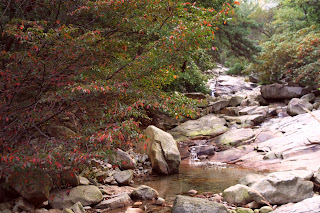 A sportive looking guide, Tony, welcomed us at the Tunxi airport, quite worried about our unsportive looks. We comforted him, saying we had the sportive stuff packed in our suitcases and we would not drag our complete luggage up to the mountain. Tony advised us to go to experience a spectacle in the local theater, later in the evening. The
driver dropped us at the Huangshan International Hotel. Kurt and I took a
walk and explored the little city and had some very local food and
beers in one of the tiniest restaurants around. After dinner we had to
hurry as Tony made a little mistake and the show started a bit earlier
than anticipated.
A sportive looking guide, Tony, welcomed us at the Tunxi airport, quite worried about our unsportive looks. We comforted him, saying we had the sportive stuff packed in our suitcases and we would not drag our complete luggage up to the mountain. Tony advised us to go to experience a spectacle in the local theater, later in the evening. The
driver dropped us at the Huangshan International Hotel. Kurt and I took a
walk and explored the little city and had some very local food and
beers in one of the tiniest restaurants around. After dinner we had to
hurry as Tony made a little mistake and the show started a bit earlier
than anticipated.
We
could hardly follow our guide walking to the theater so we got a bit
worried he would keep the same temp going up the mountain as well. The
show turned out to be an amazing spectacle with light effects, changing
decors, water falls, dancers, dangerous acrobatics and also a dramatic
storyline: men having to leave their beloved wifes for hard labor, only
meeting again when they became old. Satisfied,
we headed back to the hotel, packed our gear for the next day and hit
our beds early. Tomorrow would be a hard day: conquer around 900m
altitude difference and then walk around in the Beihai Scenic Area. Good for about 6h of walking in total.
It took a twisting 1-h drive to Yungu Temple, our starting point. Surprisingly, our sportive looking fellow wasn't that sportive at all, cause he would take the cable car up and meet us at the top. The trail was a neverending snake of stairs crawling up the mountain. While just carrying water/food/clothes for three days was heavy enough for us, workers were carying impossible loads up and down the mountain.
 |
| Workers bringing down the laundry from the hotels |
The walk up was a bit disappointing, but also fun meeting other people finding their breath again. At the end of the trail, we met our guide again. We visited the planned scenic spots in the area, but they were just too foggy to enjoy (no photo's of this included). We relaxed a bit on the room in the Shilin hotel. Suddenly we saw the clouds opening up. We regained full of energy and went back a second time to all the spots we went before.
 |
| Scenery as seen from the Begin-to-Believe-Peak |
Now we could only see the true beauty of this place. And we must admit: we also 'began to believe'. Exhausted after climbing enthusiastically up and down different trails on this mountain, we returned to the hotel. Next challenge: be first in line to enjoy the sunrise. Alarm 4.30AM!
 |
| Chinese Early Birds |
 |
| Belgian Earlier Birds |
 |
| Sunrise seen from Begin-To-Believe-Peak |
 |
| Monkey Watching The Sea (Find it) |
What a sunrise that was... we headed back for a good breakfast and then we planned a long hike: complete the West Sea Grand Canyon, which starts from the Cloud-Dispelling-Pavillion, goes all the way down, back up again, here and there over a dizzying trail, cross over the Fairy-Walking Bridge, over the second highest point of the area: Bright Summit (1880m), ending up back at the beginning.
 |
| Trail above a bottomless abyss |
 |
| Fairy-Walking Bridge |
The canyon trail was worth our every drop of sweat, although our guide didn't seem to share the same opinion. His energy visibly drained out of his body with every step, while we seemed rather tireless, which I rather grant to our excitment about this place than to our physical condition.
Coming out of the canyon, we continued over the Turtle Peak. Our guide gave up on climbing Lotus Peak (1864m), the highest point of this mountain. This peak, is surrounded by a group of lower peaks, as such, Chinese people think it looks like a lotus flower in full bloom. The way up involved steep stairs (again), so on the top, our legs started to get a bit sore.
 |
| Lotus Peak as seen from Turtle Peak |
 |
| The mandatory posing at the top |
The way down from Lotus Peak to the Jade Screen Pavillion, where our hotel was, had some spectacular views and narrow paths. We were completely exhausted when we arrived in Yupinglou hotel, enjoyed a dinner and sunset over the West Sea.
 |
| View from Lotus Peak to Jade Screen Pavillion and our hotel |
Unfortunately the Celestial Capital Peak was closed for restauration, so the only thing left to do on the last day was to hike down and visit the Tunxi Ancient Street, for some visiting some old medicine, tea, silk and stone shops.
 |
| Tunxi Ancient Street |
A writer once said:
"To enjoy the magnificence of a mountain, you have to look upwards in most cases. To enjoy Huangshan, however, you've got to look downward".
We felt very lucky to enjoy the magnificence of this mountain under perfect weather conditions, but also sad we had to leave this absolute highlight behind us.























































